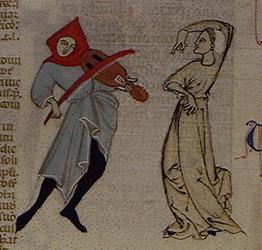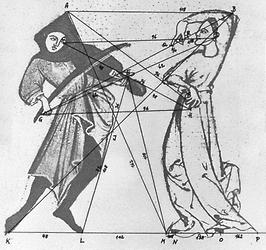Middle Ages/Geistliche Kultur#
Fiedler and Dancer#
The example is taken from Codex 32 of the University Library in Graz. The manuscript probably originated in Italy and came to the library via Seckau monastery (Styria). Some figures that are depicted on Folio 106v are about 10 cm large. An analysis of the proportions used by the artist explains why it is so lively.
Fiedler and dancer are standing on an imaginary line which connects the toes of their shoes and their robes (K-P). The distances between the points that are indicated show the following relationships: K-L und L-M 8:9 (= the musical relation of a major second); L-M und M-O as well as M-O und O-P 3:2 (= Fifth), O-P und K-L 1:2 (= Octave); L-M und M-P 10:9 (= minor second). The picture also demonstrates further such relationships which can hardly have been mere chance, especially since the figures had been corrected after the fact (for example, the bottom part of the coat on the outer right has been extended). The proportional relationships between the fiedler and the dancer are obviously supposed to symbolically demonstrate that music (= fiedler) and dance are based on the same principles. (E. Stadler)

